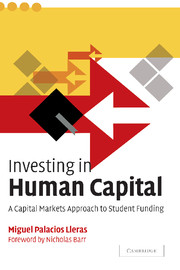Book contents
- Frontmatter
- Contents
- List of figures
- List of tables
- Foreword
- Acknowledgments
- Introduction
- Part I The problem of financing education
- Part II Equity-like investments to finance education
- Part III Implementing human capital contracts
- 8 Hurdles in the implementation of human capital contracts
- 9 Lessons from the implementation of income-contingent loans
- 10 Government-driven implementation of human capital contracts
- 11 Conclusion
- Appendix A Valuation of human capital contracts
- Appendix B Using human capital options to value income-contingent loans
- Appendix C Features of human capital contracts, income-contingent loans, and traditional mortgage-type loans
- Appendix D A developing country study
- Notes
- References
- Index
8 - Hurdles in the implementation of human capital contracts
Published online by Cambridge University Press: 08 January 2010
- Frontmatter
- Contents
- List of figures
- List of tables
- Foreword
- Acknowledgments
- Introduction
- Part I The problem of financing education
- Part II Equity-like investments to finance education
- Part III Implementing human capital contracts
- 8 Hurdles in the implementation of human capital contracts
- 9 Lessons from the implementation of income-contingent loans
- 10 Government-driven implementation of human capital contracts
- 11 Conclusion
- Appendix A Valuation of human capital contracts
- Appendix B Using human capital options to value income-contingent loans
- Appendix C Features of human capital contracts, income-contingent loans, and traditional mortgage-type loans
- Appendix D A developing country study
- Notes
- References
- Index
Summary
This chapter addresses the practical problems of implementing human capital contracts (HCCs). Understanding the hurdles that must be surpassed requires us to understand those that were presented in the past and those that are valid today.
The hurdles of the 1960s: problems of the past
In theory, HCCs should be financially viable, i.e. they should attract investors and students. Nevertheless, the implementation of this particular kind of contract requires passing several hurdles. Milton Friedman recognized some of them in 1962:
There seems no legal obstacle to private contracts of this kind, even though they are economically equivalent to the purchase of a share in an individual's earning capacity and thus to partial slavery. One reason why such contracts have not become common, despite their potential profitability to both lender and borrower, is presumably the high costs of administering them, given the freedom of individuals to move from one place to another, the need for getting accurate income statements, and the long period over which the contracts would run.
(Friedman, 1962, 103)However, most of these concerns do not hold, because (1) HCCs are not partial slavery, (2) administration costs have decreased dramatically, and (3) financial markets today accommodate extremely long-term instruments.
Human capital contracts are not partial slavery
I will argue here that HCCs, even if they are the economic equivalent of selling a right to one's future income, do not amount to slavery or servitude.
- Type
- Chapter
- Information
- Investing in Human CapitalA Capital Markets Approach to Student Funding, pp. 105 - 122Publisher: Cambridge University PressPrint publication year: 2004



